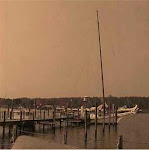April, 2010
With the support of a generous grant from the Maryland Heritage Areas Authority, the Dee of St. Mary's skipjack will undergo a tremendous restoration this year. Planning began in late 2009 and continues. This month labor began to prepare this 30-year-old wooden boat for major surgery.
The Dee of St. Mary's is 56 feet long with a 20-foot beam. Her mast is 76 feet tall and her boom 56 feet long. She carries about 2,600 square feet of sail with a hull speed of roughly 10 knots--about 11 m.p.h.
The large amount of sail enables skipjacks to pull large iron dredges--toothed scoops--along the bottom of the Chesapeake Bay even in minimal wind. The few skipjacks still oystering today use hydraulic motors to pull the dredges from the bottom.
The boom of the Dee of St. Mary's weights 750 pounds. This boom, the vessel's second, was made in 1987 in Jack Russell's yard. It is made of laminated pine. The boom is held in place by lines rigged to the mast.Helping Cap'n Jack Russell in a delicate dance of balancing and weight lifting to remove the boom are:
Antonio Hernandez, Joe Panella, Roman Pauley, Andrew Sarenceno, James Burnett, Jr. and Marcus Fields.







No comments:
Post a Comment